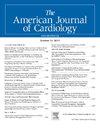Percutaneous Transcatheter Approach to Partial Anomalous Pulmonary Venous Return: A Case Series
IF 2.3
3区 医学
Q2 CARDIAC & CARDIOVASCULAR SYSTEMS
引用次数: 0
Abstract
Our study presents cases demonstrating the technique and safety of percutaneous occlusion of adult patients with partial anomalous pulmonary venous return (PAPVR). PAPVR is a rare condition that is traditionally treated surgically. Percutaneous interventions are rarely reported. Most patients with PAPVR present in youth and are surgical candidates. In nonsurgical candidates or those who prefer a percutaneous approach, there are little available data to guide therapy. Patients with PAPVR and indications for intervention were treated with percutaneous techniques to occlude anomalous venous return and relieve the hemodynamic effects of these anomalies. Several different percutaneous techniques were used, sometimes in tandem to achieve occlusion. Percutaneous closure was achieved successfully in 3 cases, with improvement in symptoms and in hemodynamic status. A total of 2 patients achieved positive remodeling in right chamber sizes. In conclusion, percutaneous occlusion of PAPVR is feasible, with a multitude of transcatheter options available. This represents a novel approach to the adult patient with PAPVR, specifically, those without a surgical option.
Condensed Abstract: Partial anomalous pulmonary venous return is a rare congenital condition, which is traditionally treated surgically. Adult patients with congenital heart disease are potentially nonsurgical candidates and, as such, benefit from percutaneous approaches. Our study describes the safety and feasibility of percutaneous closure of partial anomalous pulmonary venous return and the positive impact on hemodynamic and chamber measures.
经皮经导管入路治疗部分肺静脉异常回流:一个病例系列。
我们的研究展示了经皮肺静脉部分异常回流(PAPVR)成人患者的技术和安全性。PAPVR是一种罕见的疾病,传统上采用手术治疗。经皮介入治疗很少报道。大多数PAPVR患者出现在青年,是手术候选人。在非手术候选人或那些更喜欢经皮入路,很少有可用的数据来指导治疗。对PAPVR患者和干预指征进行经皮技术治疗,以阻断异常静脉回流,缓解这些异常的血流动力学影响。使用几种不同的经皮技术,有时串联以实现闭塞。经皮缝合成功3例,症状改善,血流动力学状态改善。两名患者在正确的腔室大小中实现了正重构。总之,经皮阻断PAPVR是可行的,有多种经导管选择。这代表了一种治疗PAPVR成人患者的新方法,特别是那些没有手术选择的患者。摘要:部分肺静脉回流异常(Partial anomalous pulmonary venous return, PAPVR)是一种罕见的先天性疾病,传统上以手术治疗为主。成年先天性心脏病患者是潜在的非手术候选者,因此可以从经皮入路中获益。我们的研究描述了经皮关闭PAPVR的安全性和可行性,以及对血流动力学和腔室测量的积极影响。
本文章由计算机程序翻译,如有差异,请以英文原文为准。
求助全文
约1分钟内获得全文
求助全文
来源期刊

American Journal of Cardiology
医学-心血管系统
CiteScore
4.00
自引率
3.60%
发文量
698
审稿时长
33 days
期刊介绍:
Published 24 times a year, The American Journal of Cardiology® is an independent journal designed for cardiovascular disease specialists and internists with a subspecialty in cardiology throughout the world. AJC is an independent, scientific, peer-reviewed journal of original articles that focus on the practical, clinical approach to the diagnosis and treatment of cardiovascular disease. AJC has one of the fastest acceptance to publication times in Cardiology. Features report on systemic hypertension, methodology, drugs, pacing, arrhythmia, preventive cardiology, congestive heart failure, valvular heart disease, congenital heart disease, and cardiomyopathy. Also included are editorials, readers'' comments, and symposia.
 求助内容:
求助内容: 应助结果提醒方式:
应助结果提醒方式:


